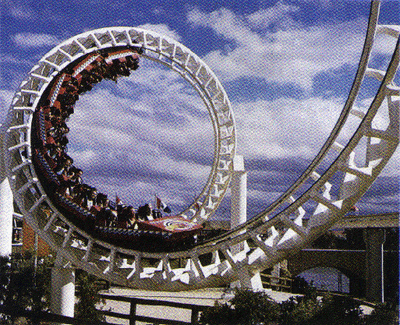
A body which travels equal distances in equal times along a circular path has a constant speed but not a constant velocity. This is because velocity is a vector quantity and as a body moves in a circle is continually changing direction, its velocity is also constantly changing. A change in velocity is an acceleration therefore a body moving uniformly in a circle is acclerating.
This is tricky to grasp at first, as in everyday language acceleration means something is getting faster and faster, though the body may be moving at a uniform speed. However in physics acceleration means a change of velocity, which means not only when the magnitude of the velocity changes but also the direction.
Radians:
Angles of a circle can also be measured in radians as well as in degrees. The angle θ, in radians is defined by equation: θ = s/r where s is the distance travelled around the circle and r is the radius of the circle. 2π radians is equivalent to 360 degrees. So 1 radian is equivalent to 360/2π which is approximately 57 degrees.
Angular velocity:
The speed of an object moving in a circle can be specified by taking the speed along a tangent at a particular instant or by its angular velocity. This is the angle swept out in a unit time by the radius joining the body to the centre of the
circle. Its is measured in radians per second (rad s^-1).
ω = θ/t, where ω is angular velocity.
Relating ω and v:
v = s/t, but s = rθ therefore v = rθ/t. ω = θ/t therefore v = rω.
v = rω
Centripetal acceleration:
a = v^2/r (for derivation click here)
The direction of the acceleration is towards the centre of the circle. This is another tricky concept to understand as when we move in a circle we feel as though we are pushing outwards and would not think we are accelerating towards the centre, in fact it would appear as if we were trying to do the opposite!
The centrifugal force, which is an imaginary force, is the force we appear to feel when travelling in circle; for example when turning a circular corner in a car. This is because at any instant in circular motion our velocity is acting tangentially to the circle; we want to move outwards. This is apparant when we whirl a weight on a string in circular motion and when it is released it moves off at a tangent at the point of release. However we do not move off at a tangent due to the centripetal force (see below) which makes a body move in a circle cover a distance inwards towards the circle from the path it would have taken if it had moved off at a tangent. Going back to the car example, if a small weight is left on the dashboard and the car undergoes circular motion the weight seems to be forced to the outer edge of the car, however it is the car moving beneath the weight towards the centre of the circle that is the force and the small weight only feels the centrifugal force as it tries to move along tangentially to the circle.
Got that?

Centipetal force:
Since a body moving in a circle is accelerating, it follows from Newton's first law of motion (see Newton's laws of motion) that there must be a force acting on it to cause the acceleration. This force, like the acceleration, will also be directed towards the centre of the circle and is called the centripetal force. It causes the body to deviate from the straight-line motion which it would naturally follow if the force were absent (see above). The value of F of the new value of the centripetal force, is given by Newton's second law, that is:
F = ma =mv^2/r
where m is the mass of the body and v is its speed in the circular path of radius r.